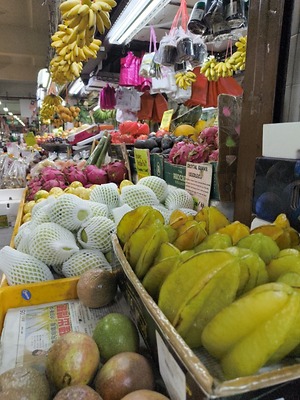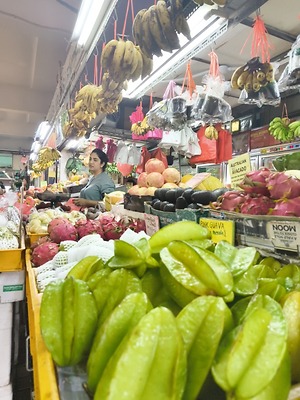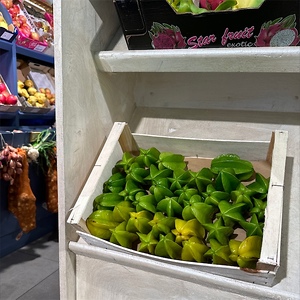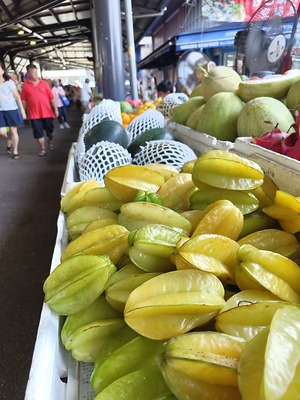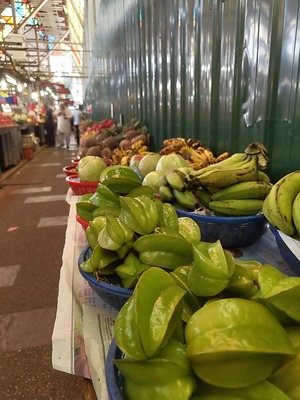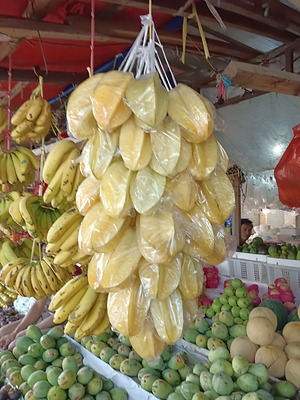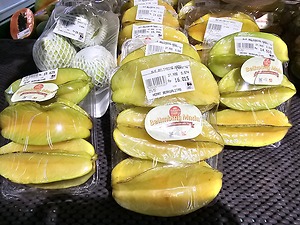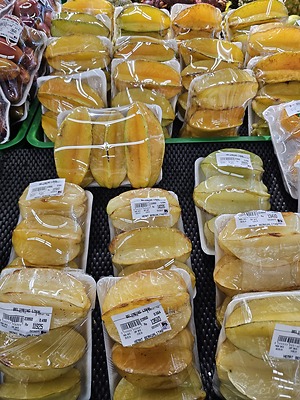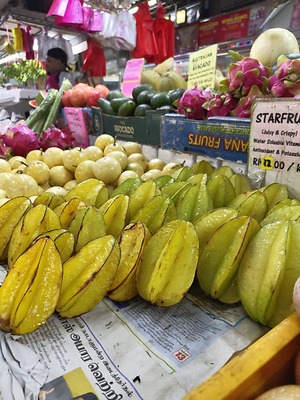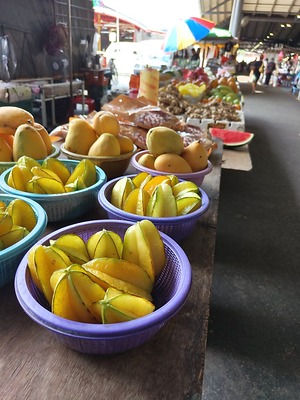

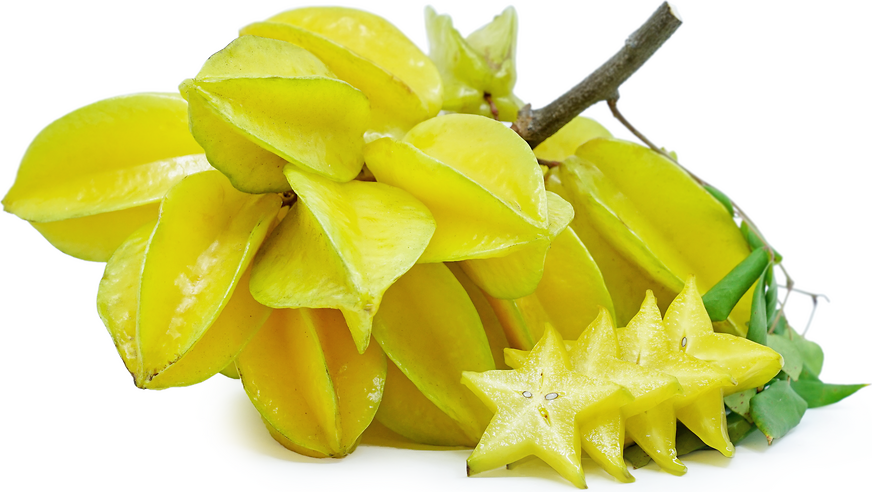
Taiwanese Star Fruit
Estimated Inventory, 20 lbs : 0
Description/Taste
Taiwanese Star fruit varies in size, depending on the specific variety, and averages 8 to 20 centimeters in length and 5 to 8 centers in diameter. The fruits showcase a distinct, pointed shape and feature 5 to 6 defined edges and flat faces on each side. When Star fruits are sliced into a cross-section, they are shaped like stars. The skin is typically waxy, glossy, and smooth to slightly bumpy, varying with each cultivar. The edges of the fruit are also more firm and rigid, while the faces are soft and delicate, being easily bruised and damaged when handled. Some consumers describe the thin faces of the fruits as having a transparent nature. Taiwanese Star fruits ripen from green to shades of yellow-green, pale yellow, golden yellow, orange-yellow, and red-orange. Underneath the surface, the pale yellow to golden yellow flesh is aqueous, succulent, crisp, and chewy. The flesh also encases 3 to 5 tiny brown seeds. Look for Star fruits with a uniform shape and size in markets and an aromatic, floral scent. Taiwanese Star fruits are edible raw once ripe and taste tropical, sweet, and sour.
Seasons/Availability
Taiwanese Star fruit is available year-round, with a peak season from December to March. Each individual variety will ripen at varying times throughout the year. May through June is the period with the lowest production.
Current Facts
Taiwanese Star fruit, botanically classified as Averrhoa carambola, is a category of varieties grown in Taiwan, belonging to the Oxalidaceae family. Star fruits have been cultivated in Taiwan since ancient times and have experienced periods of commercial popularity and decline. There are several varieties grown across the island that can be divided into wild, local types, and commercial cultivars. Local varieties of Taiwanese Star fruits were bred and created in home gardens. These types are not produced for commercial markets and are consumed as a home ingredient. Prevalent local varieties include Bamboo Leaf, Baisi, Misi, Dawu, and Jinlong. As Star fruit reached peak production in the mid to late 20th century, new commercial cultivars were primarily bred by the Fengshan Experimental Branch and other agricultural institutions for improved coloring and flavor. These commercial varieties, mainly Tainong No. 3, Tainong No. 4, Shengchui, Waiwei, Elin, and Qingyanghoulian began to dominate production, and for many years, the fruits were sold in local markets as a medicinal and culinary ingredient. They were also exported to countries worldwide. In the modern day, Taiwanese Star fruit has declined in cultivation and is a secondary crop to other commercial items such as pineapples, watermelons, and mangoes. Taiwanese varieties are labor-intensive, requiring each fruit to be hand-harvested to protect the fruit’s delicate skin, and many of these cultivars have pale yellow to green skin, even when ripe. Consumers are shifting demand to darker yellow, orange, and red-orange varieties, further causing a decline in production. Taiwanese Star fruits are also known as Carambola, and the star-shaped fruits are primarily consumed fresh in culinary preparations and beverages.
Nutritional Value
Taiwanese Star fruit varies in nutritional content, depending on the specific variety. Star fruits, in general, are a source of fiber to regulate the digestive tract, vitamin C to strengthen the immune system, and potassium to balance fluid levels within the body. Star fruits also provide iron to develop the protein hemoglobin for oxygen transport through the bloodstream, vitamin A to maintain healthy organs, zinc to protect the body against bacteria and viruses, and B vitamins. In Taiwan, Star fruits are incorporated into natural medicines to soothe sore throats and reduce phlegm. The fruits are made into juice and mixed with honey or salt. The fruits are also believed to have cooling properties due to their high water content and are eaten to lessen inflammation and replenish a cooling nature to an overheating body. Star fruit should only be consumed in limited quantities.
Applications
Taiwanese Star fruit has a sweet and sour flavor suited for fresh preparations. Each variety will have a distinct texture and taste. Most varieties are popularly consumed ripe in Taiwan and are eaten peeled or trimmed to remove tough portions of the skin. Taiwanese Star fruits are also consumed with salt as a rehydration method on hot days or dipped into sugar or soy sauce. Fresh fruits can be sliced into salads, displayed on appetizer platters, or mixed into fruit medleys. Star fruits can also be blended into juices, smoothies, and other beverages. Star fruit juice is a favored cooling drink sold through street vendors in Taiwan. Often, the drinks are flavored with a little salt or sugar to create a sweet, salty, and tangy taste. In addition to fresh preparations, Taiwanese Star fruits can be simmered into jams and jellies, used to flavor candies, or dried for extended use. They can also be pickled and cooked in savory dishes with poultry, beef, or eel. Taiwanese Star fruits pair well with honey, fruits such as bananas, papayas, pineapples, mangoes, and tangerines and spices including cloves, cinnamon, and five-spice. Whole, unwashed Taiwanese Star fruits should be ripened at room temperature. Once mature, the fruits should be immediately consumed for the best quality and flavor and can be stored in the fridge for a few days.
Ethnic/Cultural Info
Star fruits are part of a well-known legend that has been passed down between generations in China and Taiwan about how the fruits acquired their starry moniker. Legend has it that fairies traveled to Earth one evening to dance and play among fragrant flower fields. While they were frolicking, they heard a soft cry in the distance. The fairies followed the sound and encountered a woman crying in the doorway of her home. The woman told the fairies that the government had forced her to create many floral decorations for an upcoming festival, and if she didn’t finish them, they threatened her with severe punishments. The woman was afraid she would not finish making the requested floral decorations as each arrangement was complex and in the shape of lanterns and animals, requiring many flowers. The fairies were sad about the woman’s plight and decided they would help her. They ventured into the field to collect flowers and also borrowed stars from the sky and hung them on the trees around the hut for light. The fairies helped the woman finish the arrangements by dawn, but they forgot to put the stars back into the sky when they left. The stars turned into fruits, and the woman named them Star fruits in honor of the fairies and the stars that helped her achieve her goal.
Geography/History
Taiwanese Star fruit are varieties developed from species originally native to Southeast Asia. Although the origins of Star fruit are unknown, experts point to Malaysia and Indonesia as the sites of its creation. Star fruit was carried from Southeast Asia and introduced to China, where it has been cultivated since the Han Dynasty, spanning from 206 BCE to 220 CE. Later, during the Qing Dynasty, from 1644 to 1912 CE, Star fruits were planted in northern Taiwan. Cultivation of the species was initially reserved for home gardens, but over time, as planting expanded into southern Taiwan, production increased to a commercial scale. Taiwanese Star fruit experienced peak commercial cultivation in the 1960s and 1980s, and the fruits were used across the island as a medicinal and cooling drink. Over time, shifting consumer preferences led to a decline in Star fruit production in Taiwan, and the fruits became a lesser-grown crop. Today, Taiwanese Star fruit grows in home gardens, small farms, and on properties in flatlands and along low hillsides below 300 meters in elevation. In Taiwan, cultivation primarily occurs in Tainan, Changhua, Miaoli, Pingtung, Nantou, and Yunlin counties. Taiwanese Star fruit is sold domestically in Taiwan and is also exported to China, Hong Kong, Canada, Europe and the United States.
Recipe Ideas
Recipes that include Taiwanese Star Fruit. One



